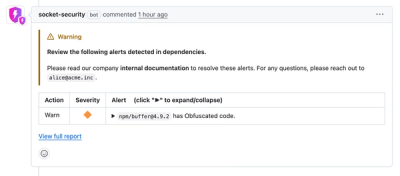
Security News
Crates.io Users Targeted by Phishing Emails
The Rust Security Response WG is warning of phishing emails from rustfoundation.dev targeting crates.io users.
Flexmaster is an adapter for ActiveRecord and MySQL that allows an application node to find a master among a list of potential masters at runtime. It trades some properties of a more traditional HA solution (load balancing, middleware) for simplicity of operation.
Your environment should be configured with 1 active master and N replicas. Each
replica should have MySQL’s global READ_ONLY flag set to true (this is really
best practices for your replicas anyway, but Flexmaster depends on it).
database.yml should contain a list of hosts – all of them potential masters, all of them potential replicas. It should look like this:
production:
adapter: mysql_flexmaster
username: flex
hosts: ["db01:3306", "db02:3306"]
production_slave:
adapter: mysql_flexmaster
username: flex
slave: true
hosts: ["db01:3306", "db02:3306"]
In this example, we’ve configured two different connections for Rails to use.
Note that they’re identical except for the slave: true key in the
production_slave YAML block. Adding slave: true indicates to Flexmaster that
this connection should prefer a read-only slave wherever possible.
The MySQL READ_ONLY flag is used to indicate a current master amongst the
cluster. Only one member of the replication chain may be read-write at any given
time. The application picks in run time, based on the READ_ONLY flag, which
host is correct.
Your ActiveRecord application will pick a correct MySQL host for the given configuration by probing hosts until it finds the correct host.
For master configurations (slave: true is not specified):
The application will probe each host in turn, and find the MySQL candidate among
these nodes that is read-write (SET GLOBAL READ_ONLY=0).
If it finds more than one node where READ_ONLY == 0, it will abort.
For slave configurations (slave: true specified):
The application will choose a replica at random from amongst those where
READ_ONLY == 1. If no active replicas are found, it will fall back to the
master.
Before each transaction is opened on the master, the application checks the
status of the READ_ONLY variable. If READ_ONLY == 0 (our active connection
is still to the current master), it will proceed with the transaction as normal.
If READ_ONLY == 1 (the master has been demoted), it will drop the current
connection and re-poll the cluster, sleeping for up to a default of 5 seconds
for a new master to be promoted. When it finds the new master, it will continue
playing the transaction on it.
The bin/master_cut script in this project will perform steps 3–5 for you.
The process of promoting a new master to head the cluster should be as follows:
Identify a new candidate master.
Ensure that all other replicas in the cluster are chained off the candidate master; you want the chain to look like this:
<existing master> -> <candidate master> -> <other replicas>
-> <other replicas>
Set the old master to READ_ONLY = 1.
Record the master-bin-log position of the candidate master (if you want to re-use the old master as a replica).
Set the new master to READ_ONLY = 0.
The application nodes will, in time, find that the old master is inactive and will move their connections to the new master.
The application will also eventually shift slave traffic to another node in the cluster.
BEGIN … END) transaction that are in-flight when the old
master goes READ_ONLY will crash. In theory there’s a workaround for this
problem, in pratice it’s rather unwieldy due to a lack of shared global
variables in MySQL.Add this line to your application’s Gemfile:
gem 'ar_mysql_flexmaster'
And then execute:
$ bundle
Or install it yourself as:
$ gem install ar_mysql_flexmaster
git checkout -b my-new-feature)git commit -am 'Added some feature')git push origin my-new-feature)FAQs
Unknown package
We found that ar_mysql_flexmaster demonstrated a not healthy version release cadence and project activity because the last version was released a year ago. It has 5 open source maintainers collaborating on the project.
Did you know?

Socket for GitHub automatically highlights issues in each pull request and monitors the health of all your open source dependencies. Discover the contents of your packages and block harmful activity before you install or update your dependencies.

Security News
The Rust Security Response WG is warning of phishing emails from rustfoundation.dev targeting crates.io users.

Product
Socket now lets you customize pull request alert headers, helping security teams share clear guidance right in PRs to speed reviews and reduce back-and-forth.

Product
Socket's Rust support is moving to Beta: all users can scan Cargo projects and generate SBOMs, including Cargo.toml-only crates, with Rust-aware supply chain checks.